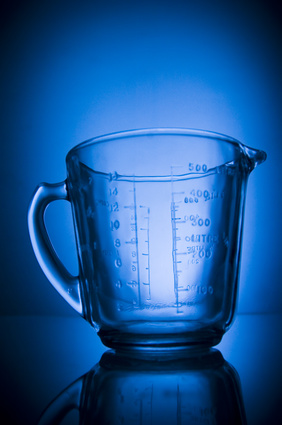
There are scientific ways to measure viscosity with a viscometer; but, a do-it-yourselfer's kitchen has most of the tools necessary to obtain a simple measurement of a motor oil's viscosity. Although, it involves some knowledge of algebra, a basic experiment can measure the time it takes for a round sphere to drop from the surface of a liquid like oil, to the bottom of a glass measuring cup or other cylinder. Once he figures that number (it's measured in centimeters per second), he can plug in the other variables into a formula to gauge the viscosity of oil at room temperature.
Weigh a clean empty measuring cup (a cylinder) on the gram scale. Note the weight on the paper.
Put about half a bottle of regular motor oil into the cylinder. Weigh the oil-filled measuring cup. Subtract the figure in Step 1 from this figure. This is the weight of the oil.
Note the height of the oil in the cup. This height should be expressed in centimeters. Note this height on the paper. (The reading on the cup also indicates the volume of the oil in milliliters).
Ask someone to stand ready with the stopwatch.
Pick up one of the clean glass marbles and position it very carefully over the liquid so that it barely touches the surface of the oil.
Simultaneously release the marble and start the stopwatch. Stop the timer the instant the marble touches the bottom of the cup. This is the velocity. The velocity is the distance that the marble ball sank (in centimeters) divided by the time it took to reach the bottom of the cup (in seconds). Note this time on the paper. Repeat Steps 4 and 5 a few times and average the answers.
Measure the density of the marble. This is the weight per unit volume, measured in grams per centimeters cubed (g/cm^3). To do this, put the marble on the gram scale and note the reading.
Measure the marble's volume by pouring some water (fill it roughly to its halfway point) into the other cup. Set down the cup and let the water settle. Note the water level. It is measured in ml, which is equivalent to cm^3.
Place the other glass marble into the water-filled measuring cup and let it sink to the bottom. Note the height of the displaced water by writing the number down.
Subtract the figure in Step 7 from the figure in Step 8. This difference equals the volume of the marble (in c/^3).
Measure the density of the oil. You already have the weight and volume of the oil. The density equals the weight divided by the volume.
Measure the radius of the marble. Put the marble on a flat, horizontal table. Using a ruler, measure the diameter of the marble. The radius is half the diameter.
Insert these numbers into the formula n=2(??)ga^2/9v to find the viscosity of the oil. The answer is expressed in terms of units of poise (g/cm times s).
Here is a list of important variables:
?? = density of the sphere?density of the oil (in g/cm^3)
g = acceleration due to gravity (980 cm/s^2)
a = radius of the sphere (in cm)
v = average velocity of the falling marble (in cm/s)